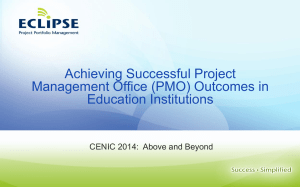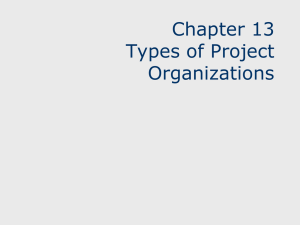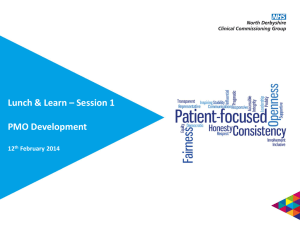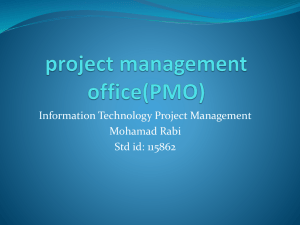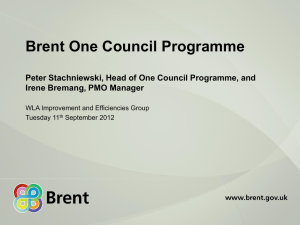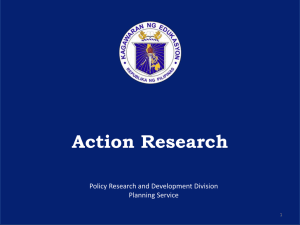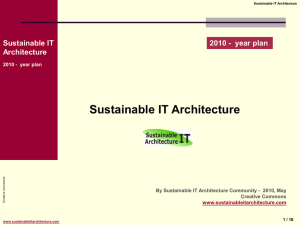Should You Establish a Project Management Office or Not?
advertisement
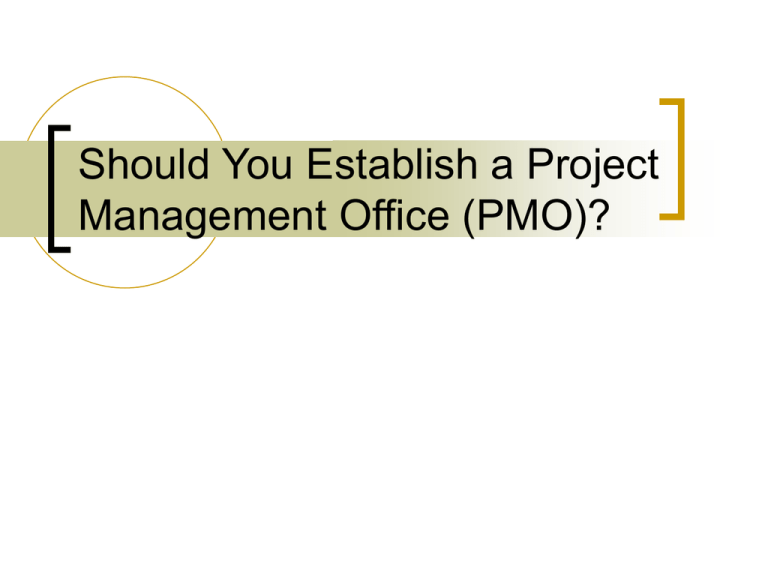
Should You Establish a Project Management Office (PMO)? What is a PMO? Deploys a consistent methodology Provides common management structure Promotes best practices Training/Mentoring/Coaching Gathers/Tracks metrics from all projects Promotes PM throughout the organization The PMO Value Proposition A successful PMO enhances an organization’s ability to execute projects and make deliverables on time and under budget while improving the overall level of quality. The PMO Value Proposition Quality Service Price A successful PMO could improve performance in all three areas of the QSP triangle The PMO Value Proposition Quality (More Valuable Deliverables) Service (More Efficient Performance) Price (Reduce Waste) The cost of the PMO must be exceeded by the benefits Styles of PMOs - Centralized One PMO office with a group of managers and services Every project includes a PM from the PMO Easier to manage and consolidate metrics Expertise may not be portable among projects Styles of PMOs - Distributed Central PMO organization not including PMs Might have multiple document repositories (for different disciplines) Supports PMs on projects Consistency is harder Coordination might be harder Styles of PMOs - Assistive No, or very small, central organization Offers guidance to other departments on project management issues Training/coaching Good way to do a little that could pay off a lot PMO’s in IT PMOs have been around for years IT “discovered” PMOs during Y2K Consulting firms used PMOs Building a PMO No two PMOs are alike Define the PMO’s function PMOs are customized to the organization Full/limited Formalize the PMO organizationally Decision making/expectations Components of a PMO Mission • What the PMO does Strategy • How it is done and for whom Sponsor • Alignment with business value Stakeholders • Vision statement Clients • Principles/Goals Objectives Acme Products/Services "The Project Management Office (PMO) implements and supports project management methodology to enable our organization to deliver projects faster, Transitional Activities cheaper, with higher quality, and within estimates and expectations." Components of a PMO • High-level set of directions Mission • Align PMO strategically Strategy Sponsor • Long-term goals (years) Stakeholders • Tactical decisions (day-to-day) Clients Objectives Products/Services Transitional Activities Components of a PMO Mission • Responsible for PMO funding • Manager PMO reports to Strategy • Critical for culture change Sponsor • Political support • Policy enforcement Stakeholders Clients Objectives Products/Services Transitional Activities Components of a PMO Mission • Person/group staked in PMO • Internal/External Strategy • Collaborative organizations Sponsor • Suppliers • Investors Stakeholders Clients Objectives Products/Services Transitional Activities Components of a PMO Mission • Requestors of PMO service Strategy • Others the PMO helps achieve their project and Sponsor business goals Stakeholders Clients Objectives Products/Services Transitional Activities Components of a PMO Mission • Concrete statements • Lower-level milestones Strategy • Achievable Sponsor • Measurable • Timed Stakeholders • Evaluated at end of project Clients and/or end of time period Objectives Products/Services Transitional Activities Components of a PMO Mission • Tangible deliverables • Services Strategy • Fulfilling others’ needs Sponsor • Achievement of objectives Stakeholders Clients Objectives Products/Services Transitional Activities Components of a PMO Mission • Building the PMO • Staffing Strategy • Procedures Sponsor Stakeholders Clients Objectives Products/Services Transitional Activities Deploying a PMO Create (or buy) a project methodology Provide training and coaching Conduct project audits/assessments Provide consolidated metrics Consulting firms can fill gaps Culture change Deploy in waves Deploying a PMO Culture change People will have to do things differently Requires different behaviors More than teaching new skills Evaluate aspects driving behavior Reinforce positives Eliminate/change negatives Consultants can drive change sometimes Deploying a PMO Culture change First do a gap analysis to show need Culture Enablers/Barriers/Attitudes Success rates Roles Skills Standards Work environment Deploying a PMO Culture change First do a gap analysis to show need Use a cross section of staff Interviews Surveys Focus groups Use the gap analysis to define the future look of the PMO Deploying a PMO Deploy in waves Don’t change things all at once General awareness sessions Project management training Standards/Templates Reward/Recognition system Get management buy-in Audits and evaluations PMO support organization The Methodology Processes Procedures Templates Best Practices Standards/Guidelines/Policies Must be adaptable “Methodology management” Methodology Management Development Support Build/Buy/Buy and Customize Questions/Repository/Training Enhancements Expanding/Training/Enhancing Don’t over-engineer it. Don’t let methodology get in the way. PMO Training Scope of training Determine needs Respond to feedback Create training strategy Teach all stakeholders Decide which skills you will teach Delivery, audience, timing, in/outside Develop/buy curriculum PMO Coaching More informal than training More one-on-one Talking through situations Align coaching services with deployment Audits In order for new processes to be adopted successfully, they must be used properly Project-level audits Don’t audit every projects Identifies failures to use methodology Organizational audits Audits Project-level audits Did stakeholders participate? Stakeholders approve project definition? Work plan being used? Is it accurate? All deliverables completed? On track: cost, duration, quality? Are risks being managed? Are issues being managed? Consider outsourcing this effort. Audits Organizational-level audits Show how the “gap” is closing Keep you stakeholders informed Identifies compliance (or not) Identifies whether or not the PMO is a good idea for the organization Identifies if PMO is being delivered in the best way for the organization Consider outsourcing this effort. Audits Trend successive audits Identify changes that need to be made Identify training needs Stress progress along lines of business alignment Don’t be afraid to say things are wrong It’s probably not going to be totally successful Metrics Consolidate metrics and reporting Organization-wide portfolio This is a great way to be visible and useful to upper management This can also be time consuming Very hard to measure the value of the PMO precisely (like holding a cloud) Metrics Problems gathering project metrics Timeliness –response is low priority Accuracy – reported status is not correct Completeness – too brief Be clear and concise Use standards and automation Metrics Savings with scope change mgmt. Savings with risk management Savings by proactive action Savings by way of re-use Assess the value of increased quality The PMO is likely to increase everyone’s workload and responsibility… so probably won’t be liked by everyone Other PMO Services Document Repository Re-use of templates, schedules, project documents, etc. Use technology Historical archive Other PMO Services Best Practices Post-mortem analysis on projects Lessons learned Improve methods, procedures Other PMO Services Common Resource Pool Shared staff Re-used documents/forms Software, code library FAQs Document review services Document preparation
